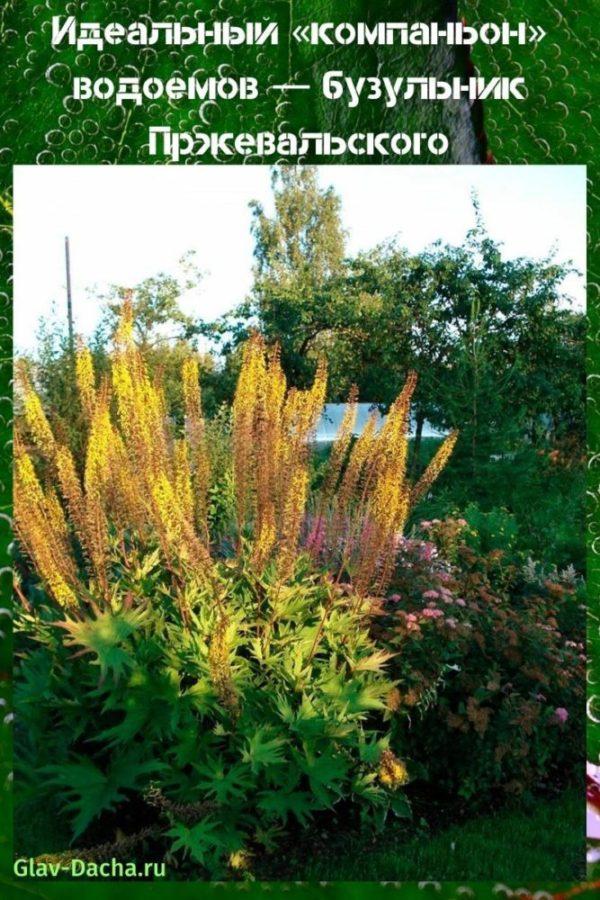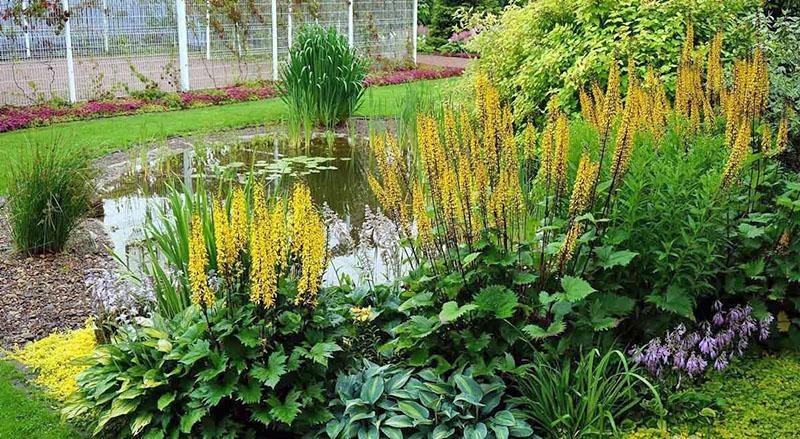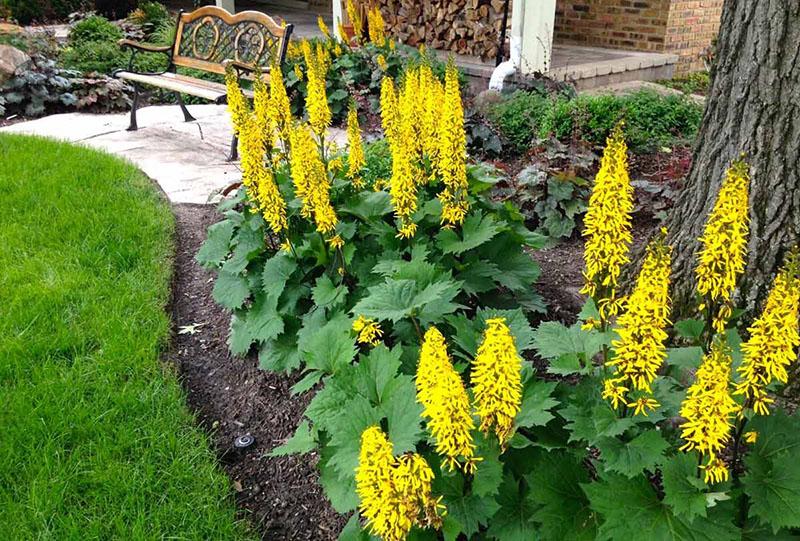An ideal "companion" of water bodies - Przewalski's buzulnik
 The landscape design of the pond will take on a special majestic look if you plant Przewalski's buzulnik near it. The herbaceous plant reaches 1.5-2 meters in height and has rich foliage. Luxurious and at the same time sophisticated flowering candles in a deep yellow hue recall the medieval guardians of royal castles. Therefore, a perennial can rightfully become a worthy decoration of a personal plot.
The landscape design of the pond will take on a special majestic look if you plant Przewalski's buzulnik near it. The herbaceous plant reaches 1.5-2 meters in height and has rich foliage. Luxurious and at the same time sophisticated flowering candles in a deep yellow hue recall the medieval guardians of royal castles. Therefore, a perennial can rightfully become a worthy decoration of a personal plot.
Spectacular Przewalski Buzulnik close-up
 The culture belongs to the Astrov family. It has been growing in one place for 20 years. The leaves of the plant are especially decorative. In width, they can reach up to 60 cm, while standing out with a powerful section.
The culture belongs to the Astrov family. It has been growing in one place for 20 years. The leaves of the plant are especially decorative. In width, they can reach up to 60 cm, while standing out with a powerful section.
More than 150 varieties of Przewalski Buzulnik (ligularia przewalskii) are known, the distinctive features of which are the shape of the foliage:
- heart-shaped;
- finger-split;
- oval;
- dissected;
- serrated / carved.
 Massive leaves on tall cuttings form a dense basal rosette. The color of the foliage comes in various shades. The most popular is deep green. Still, there are specimens with purple or red-brown tints. In some varieties, the lower part of the deciduous plate surprises with a contrasting purple color or slight pubescence.
Massive leaves on tall cuttings form a dense basal rosette. The color of the foliage comes in various shades. The most popular is deep green. Still, there are specimens with purple or red-brown tints. In some varieties, the lower part of the deciduous plate surprises with a contrasting purple color or slight pubescence.
The leaves retain their attractiveness throughout the growing season. During flowering, they become covered with bronze or coffee stains, which become larger as they grow.
 Special attention should be paid to spectacular peduncles, towering above the ground (1.5 m). When the wind flutters the spike-shaped candles, one gets the impression that a whole regiment of soldiers is marching or “the judges, shy in a row, shake their heads quietly”. Small and often planted flowers, which are collected in complex inflorescences, give them special pomp.
Special attention should be paid to spectacular peduncles, towering above the ground (1.5 m). When the wind flutters the spike-shaped candles, one gets the impression that a whole regiment of soldiers is marching or “the judges, shy in a row, shake their heads quietly”. Small and often planted flowers, which are collected in complex inflorescences, give them special pomp.
Flowering process:
- lasts for one summer month (depending on the region and variety);
- passes in stages (bottom-up);
- bewitches with fiery yellow compositions.
 Flowers can be both large and small. They often resemble chamomile, but only with rather elongated and even curled petals. At the same time, the core of each of them is distinguished by double pistils and protruding filamentous stamens. All this in the complex gives the flowering bush a unique decorative effect.
Flowers can be both large and small. They often resemble chamomile, but only with rather elongated and even curled petals. At the same time, the core of each of them is distinguished by double pistils and protruding filamentous stamens. All this in the complex gives the flowering bush a unique decorative effect.
Popular varieties
Usually, in the natural environment, Przewalski's buzulnik grows near reservoirs or on forest edges. At the same time, the perennial is very popular in China, especially as a medicinal plant. The roots of the grass contain strong antibacterial substances, which explains its demand in the Middle Kingdom.
In horticulture, 3 luxurious varieties of culture have been bred:
- Light Fingered. The heavily hewn foliage is in harmony with the yellow flowers.

- Maple-leaved. Leaves resemble maple leaves in structure, but are slightly larger (up to 25 cm in diameter).

- Rocket. Tall shrub up to 2 m in height. Deciduous plates are triangular in shape with large jagged edges. In August, the foliage takes on a purple hue.

At the end of flowering, fruits are formed on the peduncles. The seed pods have a kind of “parachute” with which the culture is self-seeding. In landscape design, varieties with unusual openwork foliage are often used.Dense massive bushes retain their decorative properties until late autumn.
When choosing a variety of a herbaceous plant, the structure of the foliage usually plays the main role, because the shape and shade of flowers in representatives of the Astrov family are the same.
Planting Buzulnik Przewalski
 Choosing the right place depends on the culture. The plant thrives in shady corners of the garden and on humid areas of land, for example, near a pond or an artificial reservoir. Moreover, due to its tallness, Przewalski's buzulnik is always relegated to the background in the front gardens. In addition, voluminous bushes with bright yellow flowers make a luxurious hedge along the alley or curb. At the same time, deciduous or coniferous trees are necessarily planted in the background, which will create a good shade.
Choosing the right place depends on the culture. The plant thrives in shady corners of the garden and on humid areas of land, for example, near a pond or an artificial reservoir. Moreover, due to its tallness, Przewalski's buzulnik is always relegated to the background in the front gardens. In addition, voluminous bushes with bright yellow flowers make a luxurious hedge along the alley or curb. At the same time, deciduous or coniferous trees are necessarily planted in the background, which will create a good shade.
Perennial does not tolerate direct sunlight, as well as drafts. This leads to wilting of foliage and the appearance of burns. And from a strong gusty wind, tall stems break.
 Planting and caring for the Przewalski buzulnik is accompanied by rather painstaking procedures. To begin with, prepare the soil in a separate area: loosen and fertilize with humus mixed with wood ash. Additionally, substrates are introduced that retain moisture. The event is planned for late autumn: November-December, so that the seeds undergo natural stratification. The seeding depth is 2 cm. When shoots appear (in spring), young seedlings are dug up and transferred to a permanent place in the garden.
Planting and caring for the Przewalski buzulnik is accompanied by rather painstaking procedures. To begin with, prepare the soil in a separate area: loosen and fertilize with humus mixed with wood ash. Additionally, substrates are introduced that retain moisture. The event is planned for late autumn: November-December, so that the seeds undergo natural stratification. The seeding depth is 2 cm. When shoots appear (in spring), young seedlings are dug up and transferred to a permanent place in the garden.
Landing in open ground

Be sure to observe the agrotechnology of planting:
- distance between bushes up to 100 cm;
- landing along with an earthen lump;
- mulching the site (straw, hay, sawdust);
- introduction of organic feeding (manure is diluted with water in a ratio of 1:10).
Throughout the growing season, the soil moisture is constantly monitored. For this, an irrigation system is organized, depending on the drying out of the soil. At the same time, mulch will keep moisture in the ground for a long time. They also control the degree of shade of the area. Then, with such care, Przewalski's buzulnik will bloom after 3-4 years.
The seeds are harvested in August. The planting material is well dried. Then, in the same autumn, they are sown in the ground.
 Herbaceous crops are also grown in seedlings. At the beginning of March, prepare a container with a nutritious soil mixture and thoroughly moisten it. Then the seeds are sown to a depth of 1 cm and sprayed with a spray bottle. The container is covered with foil / glass and placed in a room with a moderate temperature (16-18 ° C). Before the first shoots appear, the planting is aired and watered. Sprouts with 3 full leaves are transplanted into separate pots. A transplant into open ground is carried out when the threat of repeated frost has passed.
Herbaceous crops are also grown in seedlings. At the beginning of March, prepare a container with a nutritious soil mixture and thoroughly moisten it. Then the seeds are sown to a depth of 1 cm and sprayed with a spray bottle. The container is covered with foil / glass and placed in a room with a moderate temperature (16-18 ° C). Before the first shoots appear, the planting is aired and watered. Sprouts with 3 full leaves are transplanted into separate pots. A transplant into open ground is carried out when the threat of repeated frost has passed.
Subtleties of vegetative propagation
 On one flowerbed, Przewalski's buzulnik will grow up to 20 years. However, for this, the rejuvenation of the bushes is carried out every 5 years. Instances are divided into several parts.
On one flowerbed, Przewalski's buzulnik will grow up to 20 years. However, for this, the rejuvenation of the bushes is carried out every 5 years. Instances are divided into several parts.
Then the rhizomes are carefully selected and prepared:
- cleaned of dirt;
- wash;
- cut into pieces, each of which must have a fertile kidney;
- the sections are treated with a disinfectant solution (based on potassium permanganate or charcoal).
 The resulting cuttings are transferred into previously prepared square-shaped wells (with a side of 40 cm). At the bottom, a drainage cushion is formed, and fertilization (transfer) is also applied. A clay substrate or peat is added to too airy soil. Mix everything thoroughly. After planting, the site is thoroughly spilled with water (3-4 liters per bush).
The resulting cuttings are transferred into previously prepared square-shaped wells (with a side of 40 cm). At the bottom, a drainage cushion is formed, and fertilization (transfer) is also applied. A clay substrate or peat is added to too airy soil. Mix everything thoroughly. After planting, the site is thoroughly spilled with water (3-4 liters per bush).
 Usually, the procedure is carried out in the fall, but no later than September 15-20. Then, before the onset of cold weather, the seedling will be able to grow strong enough and accumulate for wintering. Observing all the intricacies of the cultivation of Przewalski's buzulnik, you can get a wonderful ornamental plant in your garden.
Usually, the procedure is carried out in the fall, but no later than September 15-20. Then, before the onset of cold weather, the seedling will be able to grow strong enough and accumulate for wintering. Observing all the intricacies of the cultivation of Przewalski's buzulnik, you can get a wonderful ornamental plant in your garden.